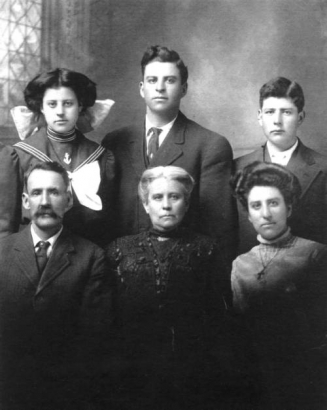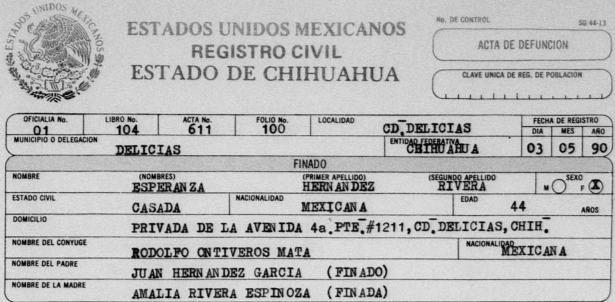When genealogists and historians research Spanish-surnamed ancestors and families, they may come across naming conventions, traditions, and customs that differ from English-speaking families. While there are variations in different locations, time periods, and families, this article highlights two of the more common differences researchers may encounter.
A major difference researchers encounter is the number of surnames. In Spain and Spanish American countries, except Argentina, each person has two surnames. Traditionally, the first surname is paternal and comes from the father, while the second surname is maternal and comes from the mother. In recent years, some countries have allowed parents to alter the order of surnames for their children, but in historical records paternal surnames generally precede maternal names. Some of the Spanish records in Arizona, California, Colorado, Florida, New Mexico, Puerto Rico, and Texas may use two surnames, although this varies by time period.
The death certificate of Esperanza Hernández Rivera from Delicias, Chihuahua, Mexico, is an excellent example. The certificate uses “apellido,” the Spanish word for surname, last name, or family name in English. Hernández is the paternal surname Esperanza inherited from her father and Rivera is the maternal surname she inherited from her mother. Vocabulary may vary in records and researchers may see “paternal/maternal surname” or “first/second surname” or simply “apellidos” in the plural.
The death certificate lists Esperanza’s father as Juan Hernández García and her mother as Amalia Rivera Espinoza and confirms the paternal and maternal surnames. The fact her parents also have both surnames recorded offers valuable clues for researchers who want to trace this family back another generation. Since Juan inherited Hernández from his father and García from his mother, the researcher knows the surnames of Esperanza’s grandparents. This information can be used to find Juan’s correct birth record, which could be tricky since "Juan Hernández" is a common name. By knowing that García is Juan's maternal surname, researchers can avoid confusing Esperanza’s father with another Juan Hernández. The term “finado” in parenthesis means they are deceased.
Just about every person listed on Esperanza’s death certificate – from witnesses to the government official certifying it – has two surnames listed. While this is the norm on legal documents, official papers, and vital records, in everyday life it is common to only use a paternal surname. For example, the Spanish actress Penélope Cruz often omits her maternal surname Sánchez and the Mexican soccer player Rafael Márquez does not have his maternal surname Álvarez printed on his jersey.
Another important Spanish-speaking naming custom is that women usually do not change their surnames when they marry. In our example, we see that Esperanza has kept her maiden name of Hernández even though the certificate states she was “casada” (married) and her “cónyuge” (spouse) was Rodolfo Ontiveros Mata. Women keeping their maiden names is helpful when sorting through records where couples have the same names as contemporary neighbors, such as census records.
In a local example, Policarpio Córdova and his family took a family photo in Trinidad, Colorado, in the early part of the 20th century. He is seated to the left of his wife who is listed as Gumucinda Chacón – not Córdova – and they are surrounded by their children: Isabel, Rosa, Amadeo, and Policarpio Córdova, Jr.
Nevertheless, there are women who do adopt their husband’s surname. Some replace their maiden name, as is customary in English-speaking countries, while others add “de” – meaning “of” – between the surnames. For example, Cristina Fernández was the first lady, vice-president, and president of Argentina. She was married to Néstor Kirchner, now deceased, and goes by Cristina Fernández de Kirchner.
When people with two surnames from Spanish-speaking countries emigrate to countries where one surname is custom, they have several choices. Some will drop one surname, usually the maternal or second surname. Others may choose to hyphenate their names. In the first example, Esperanza could have gone by Esperanza Hernández or Esperanza Hernández-Rivera in the United States, or even Esperanza Ontiveros if she had adopted her husband’s surname. To avoid missing any records, good researchers would look up all these variations in their research.
As researchers encounter different naming customs in their work, it is important to be familiar with differences. This helps to avoid mistakes, focus on the correct families, and save time. It also fosters an appreciation and respect for different cultures, traditions, and customs.




Comments
Very good explanation. I
Very good explanation. I always wondered how the two names connected to each other. Thank you for the clear and precise definition. John MacLean
My pleasure. Be sure to check
My pleasure. Be sure to check out our 10-part "Hispanic and Southwest Genealogy Tips and Strategies" for more info.
Thanks Nicolás for this
Thanks Nicolás for this article. I am a chilean person doing my big family tree since about 10 years ago, and my dream is to find a genealogy software that can handle both surnames.
I check from time to time all genealogy software to see if my prayers are answered, but so far it has been quite deceiving, no one looks to handle this. This should be as universal as it gets, and it could be a configuration option for every person in the tree.
If by miracle you stumble on such a piece of software, please please let me know.
Thanks and best regards, rpetitpas at gmail dot com.
Even more confusing is when
Even more confusing is when they have two first names, such as Lin-Manuel Miranda with parents from Puerto Rico.
It is important to note that
It is important to note that with surnames of Portuguese origin it works the other way around. So if a Brazilian, Portuguese or Mozambican for example is asked by their names, the first surname comes from his/her mother and the last from the father.
For example: José Cavalcante Albuquerque: Cavalcante would be his mother's surname, and Albuquerque his father's. Some surnames are so traditional that cannot be separated: Sara Lopes Vidal de Negreiros: Lopes is her mother's and Vidal de Negreiros comes from her father, due to it being a surname that came from an aristocatic family from the past. Other examples include: Castello Branco, Villas Bôas, Espírito Santo. Another thing are the prepositions: they matter in Portuguese, just like Van der for the dutch, "de" or "e" are a particle of the surnames. José Rodrigues de Oliveira, has as last name "de Oliveira". Hope this can help someone looking for Portuguese surnames...
My inheritance states I’ll
My inheritance states I’ll have to have the surnames of the original families so dose Mean my great great grandfather married into the Ashworth’s family am I still here
What is trying to say is Emma
What is trying to say is Emma a link to the Ashworth family in Heritage
I like someone with an s in
I like someone with an s in their name
I took a few Spanish courses
I took a few Spanish courses at Overland Learning Centre in north Toronto, and our teacher was a Guatemalan immigrant named Ivan Roma Guzman. According to Spanish naming customs, Roma is his "apellido paterno" and Guzman is his "apellido materno".
In Brazil what does the
In Brazil what does the letter r mean, when between the surnames of two individuals, e.g., Kram r Kirschbaum? And perhaps you can help me ...I have a relative whose great grandparents are my grandparents. Are we second cousins, first cousins once removed, or what? Thank you so much. My email is Bx60NY@aol.com
Add new comment